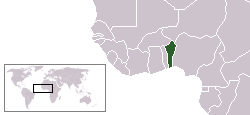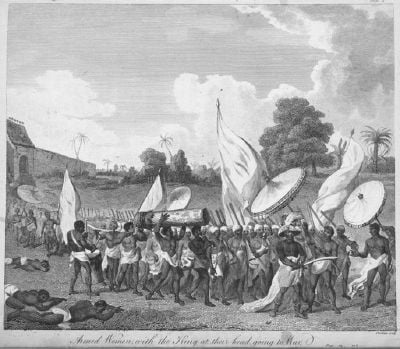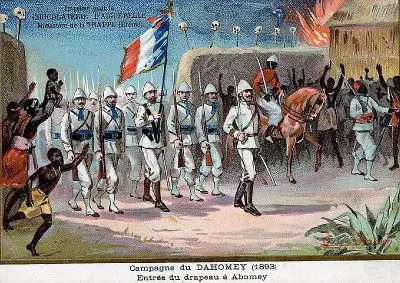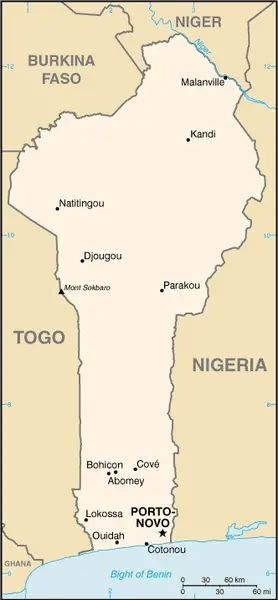Difference between revisions of "Republic of Benin" - New World Encyclopedia
| Line 101: | Line 101: | ||
===Post-colonial=== | ===Post-colonial=== | ||
| − | + | After 1960, there were coups and regime changes, with the figures of [[Hubert Maga]], [[Sourou Migan Apithy|Sourou Apithy]], [[Justin Ahomadégbé]], and [[Émile Derlin Zinsou]] dominating; the first 3 each represented a different area and ethnicity of the country. These 3 agreed to form a [[Presidential Council (Benin)|Presidential Council]] after violence marred the 1970 elections. | |
| − | + | On 7 May 1972, Maga ceded power to Ahomadégbé. On 26 October 1972, Lt. Col. [[Mathieu Kérékou]] overthrew the ruling triumvirate, becoming president and stating that the country would not "burden itself by copying foreign [[ideology]], and wants neither Capitalism, Communism, nor Socialism". On 30 November 1974, he announced that the country was officially [[Marxism|Marxist]], under control of the Military Council of the Revolution (CMR), which nationalized the petroleum industry and banks. On 30 November 1975, he renamed the country the [[People's Republic of Benin]].<ref name="Dickovick2012">{{cite book|last=Dickovick |first= J. Tyler|title=Africa 2012|url=https://archive.org/details/africa20120000dick|url-access=registration|access-date=5 March 2013|date=9 August 2012|publisher=Stryker Post|isbn=978-1-61048-882-2|page=[https://archive.org/details/africa20120000dick/page/69 69]}}</ref><ref name="HoungnikpoDecalo2012">{{cite book|last1=Houngnikpo|first1=Mathurin C.|last2=Decalo|first2=Samuel|title=Historical Dictionary of Benin|url=https://books.google.com/books?id=0yGPTsRubWEC&pg=PR33|access-date=5 March 2013|date=14 December 2012|publisher=Rowman & Littlefield|isbn=978-0-8108-7171-7|page=33|archive-url=https://web.archive.org/web/20140423214217/http://books.google.com/books?id=0yGPTsRubWEC&pg=PR33|archive-date=23 April 2014|url-status=live}}</ref> The regime of the People's Republic of Benin underwent changes over the course of its existence: a [[Nationalism|nationalist]] period (1972–1974); a [[Socialism|socialist]] phase (1974–1982); and a phase involving an opening to Western countries and [[economic liberalism]] (1982–1990).<ref name="auto">{{Cite web|url=http://afriquepluriel.ruwenzori.net/benin1.htm|archive-url=https://web.archive.org/web/20210304083636/http://afriquepluriel.ruwenzori.net/benin1.htm|archive-date=4 March 2021|title=Wikiwix[archive]|access-date=11 December 2021}}</ref> | |
| + | |||
| + | In 1974, under the influence of young revolutionaries – the "Ligueurs" - the government embarked on a socialist program: nationalization of strategic sectors of the economy, reform of the education system, establishment of agricultural cooperatives and new local government structures, and a campaign to eradicate "[[Feudalism|feudal]] forces" including [[tribalism]]. The regime banned opposition activities. Mathieu Kérékou was elected president by the National Revolutionary Assembly in 1980, re-elected in 1984. Establishing relations with [[China]], [[North Korea]], and [[Great Socialist People's Libyan Arab Jamahiriya|Libya]], he put "nearly all" businesses and economic activities under state control, causing foreign investment in Benin to dry up.<ref name="kneib">{{Cite book|title=Benin|last=Kneib |first= Martha|pages=[https://archive.org/details/benin0000knei/page/22 22–25]|isbn=978-0-7614-2328-7|date=7 January 2007|publisher=Marshall Cavendish Benchmark |url=https://archive.org/details/benin0000knei/page/22}}</ref> Kérékou attempted to reorganize education, pushing his own aphorisms such as "Poverty is not a fatality".<ref name="kneib"/> The regime financed itself by contracting to take nuclear waste, first from the Soviet Union and later from France.<ref name="kneib"/> | ||
| + | |||
| + | In the 1980s, Benin experienced higher economic growth rates (15.6% in 1982, 4.6% in 1983 and 8.2% in 1984), until the closure of the Nigerian border with Benin led to a drop in customs and tax revenues. The government was no longer able to pay civil servants' salaries.<ref name="auto"/> In 1989, riots broke out when the regime did not have enough money to pay its army. The banking system collapsed. Eventually, Kérékou renounced [[Marxism]], and a convention forced Kérékou to release political prisoners and arrange elections.<ref name="kneib"/> [[Marxism–Leninism]] was abolished as the country's form of government.<ref>{{cite web|url=http://www.socialist.net/history-people-s-republic-of-benin.htm|title=A Short History of the People's Republic of Benin (1974–1990)|publisher=Socialist.net|date=27 August 2008|access-date=2 May 2010|archive-url=https://web.archive.org/web/20100423134048/http://www.socialist.net/history-people-s-republic-of-benin.htm|archive-date=23 April 2010|url-status=live}}</ref> | ||
| + | |||
| + | The country's name was officially changed to the'' Republic of Benin'' on 1 March 1990, after the newly formed government's [[constitution]] was completed.<ref>{{cite web|url=http://flagspot.net/flags/bj.html|title=Benin|publisher=Flagspot.net|access-date=2 May 2010|archive-url=https://web.archive.org/web/20100612012647/http://flagspot.net/flags/bj.html|archive-date=12 June 2010}}</ref> | ||
| + | [[File:BoniYayi inauguration2006.jpg|thumb|right|[[Thomas Boni Yayi|Yayi Boni]]'s 2006 presidential inauguration]] | ||
| + | Kérékou lost to [[Nicéphore Soglo]] in a 1991 election and became the first President on the African mainland to lose power through an election.<ref>{{cite news |title=Official Result in Benin Vote Shows Big Loss for Kerekou |url=https://www.nytimes.com/1991/03/26/world/official-result-in-benin-vote-shows-big-loss-for-kerekou.html |work=The New York Times |date=26 March 1991 |access-date=1 June 2022 |archive-date=1 June 2022 |archive-url=https://web.archive.org/web/20220601223719/https://www.nytimes.com/1991/03/26/world/official-result-in-benin-vote-shows-big-loss-for-kerekou.html |url-status=live }}</ref> Kérékou returned to power after winning the 1996 vote. In 2001, an election resulted in Kérékou winning another term, after which his opponents claimed election irregularities.<ref>{{cite news |title=ben007 President Kerekou re-elected in Benin |url=http://www.afrol.com/News2001/ben007_kerekou_wins.htm |work=www.afrol.com |access-date=1 June 2022 |archive-date=1 June 2022 |archive-url=https://web.archive.org/web/20220601223719/http://www.afrol.com/News2001/ben007_kerekou_wins.htm |url-status=live }}</ref> In 1999, Kérékou issued a national apology for the substantial role that Africans had played in the Atlantic slave trade.<ref>[[Henry Louis Gates|Gates, Henry Louis]], "[https://www.nytimes.com/2010/04/23/opinion/23gates.html?pagewanted=all Ending the Slavery Blame-Game] {{Webarchive|url=https://web.archive.org/web/20170307174002/http://www.nytimes.com/2010/04/23/opinion/23gates.html?pagewanted=all |date=7 March 2017 }}". ''The New York Times'', 22 April 2010</ref> | ||
| + | |||
| + | Kérékou and former president Soglo did not run in the 2006 elections, as both were barred by the constitution's restrictions on age and total terms of candidates.<ref>{{cite news |title=President Mathieu Kerekou leaves after 29 years |url=https://www.thenewhumanitarian.org/fr/node/225956 |work=The New Humanitarian |date=7 April 2006 |language=fr |access-date=1 June 2022 |archive-date=1 June 2022 |archive-url=https://web.archive.org/web/20220601222447/https://www.thenewhumanitarian.org/fr/node/225956 |url-status=live }}</ref> On 5 March 2006, [[Beninese presidential election, 2006|an election]] resulted in a [[Two-round system|runoff]] between [[Thomas Boni Yayi|Yayi Boni]] and [[Adrien Houngbédji]]. The runoff election was held on 19 March and was won by Boni,<ref>{{cite news |title=Boni wins Benin presidential election: official |url=https://www.abc.net.au/news/2006-03-23/boni-wins-benin-presidential-election-official/825650 |work=ABC News |date=22 March 2006 |language=en-AU |access-date=1 June 2022 |archive-date=1 June 2022 |archive-url=https://web.archive.org/web/20220601221645/https://www.abc.net.au/news/2006-03-23/boni-wins-benin-presidential-election-official/825650 |url-status=live }}</ref> who assumed office on 6 April.<ref>{{cite news |title=Celebration As Boni Takes Over |url=https://allafrica.com/stories/200604070127.html |access-date=1 June 2022 |archive-date=18 April 2006 |archive-url=https://web.archive.org/web/20060418003819/http://allafrica.com/stories/200604070127.html |url-status=live }}</ref> Boni was [[Beninese presidential election, 2011|reelected in 2011]], taking 53.18% of the vote in the first round—enough to avoid a runoff election. He was the first president to win an election without a runoff since the restoration of democracy in 1991.<ref>{{cite news |title=Benin's Boni Yayi wins second term - court |url=https://www.reuters.com/article/benin-election-idAFLDE72K0KE20110321 |work=Reuters |date=21 March 2011 |language=en |access-date=1 June 2022 |archive-date=1 June 2022 |archive-url=https://web.archive.org/web/20220601221256/https://www.reuters.com/article/benin-election-idAFLDE72K0KE20110321 |url-status=live }}</ref> | ||
| + | |||
| + | In the [[Beninese presidential election, 2016|March 2016 presidential elections]] in which Boni Yayi was barred by the constitution from running for a third term, businessman [[Patrice Talon]] won the second round with 65.37% of the vote, defeating investment banker and former Prime Minister [[Lionel Zinsou]]. Talon was sworn in on 6 April 2016.<ref>{{Cite news|url=https://www.reuters.com/article/us-benin-election-idUSKCN0X31QO|title=Businessman sworn in as Benin's president|date=6 April 2016|newspaper=Reuters|access-date=1 May 2016|archive-url=https://web.archive.org/web/20160417043022/http://www.reuters.com/article/us-benin-election-idUSKCN0X31QO|archive-date=17 April 2016|url-status=live}}</ref> Speaking on the same day that the Constitutional Court confirmed the results, Talon said that he would "first and foremost tackle constitutional reform", discussing his plan to limit presidents to a single term of 5 years in order to combat "complacency". He said that he planned to slash the size of the government from 28 to 16 members.<ref>{{Cite news|url=https://www.reuters.com/article/us-benin-election-idUSKCN0WS08X|title=Newly-elected Benin president aims to reduce presidential terms|date=26 March 2016|newspaper=Reuters|access-date=1 May 2016|archive-url=https://web.archive.org/web/20160503063033/http://www.reuters.com/article/us-benin-election-idUSKCN0WS08X|archive-date=3 May 2016|url-status=live}}</ref> In April 2021, President Patrice Talon was re-elected, with more than 86.3% of the votes cast, in Benin's presidential [[2021 Beninese presidential election|election]].<ref>{{cite web|url=https://abcnews.go.com/International/wireStory/benins-president-wins-election-preliminary-results-77053903|title=Benin's president wins re-election in preliminary results|website=[[ABC News]]|access-date=14 April 2021|archive-date=14 April 2021|archive-url=https://web.archive.org/web/20210414075040/https://abcnews.go.com/International/wireStory/benins-president-wins-election-preliminary-results-77053903|url-status=live}}</ref> The change in election laws resulted in total control of parliament by president Talon's supporters.<ref>{{Cite web|url=https://www.aljazeera.com/news/2021/4/11/vote-counting-in-benin-after-election-marked-by-violent-protests|title=Benin vote count begins after opposition groups boycott election|website=www.aljazeera.com|access-date=19 April 2021|archive-date=19 April 2021|archive-url=https://web.archive.org/web/20210419074916/https://www.aljazeera.com/news/2021/4/11/vote-counting-in-benin-after-election-marked-by-violent-protests|url-status=live}}</ref> | ||
| + | |||
| + | In February 2022, [[W National Park massacre|Benin saw its largest terrorist attack in history]].<ref>{{Cite web |title=Five rangers, soldier killed in attack in Benin, park management says |url=https://news.yahoo.com/five-rangers-soldier-killed-attack-203717334.html |access-date=2022-02-16 |website=news.yahoo.com |date=9 February 2022 |language=en-US}}</ref> | ||
| + | |||
| + | On 20 February 2022, President [[Patrice Talon]] inaugurated an exhibition with 26 pieces of sacred art returned to Benin by [[France]], 129 years after they were looted by colonial forces.<ref>{{cite news | url=https://www.lemonde.fr/afrique/article/2022/02/21/regardez-la-puissance-de-ces-objets-le-benin-expose-les-vingt-six-uvres-restituees-par-la-france_6114618_3212.html | title=Le Bénin expose les vingt-six œuvres restituées par la France : « Regardez la puissance de ces objets ! » | newspaper=Le Monde.fr | date=21 February 2022 }}</ref> | ||
== Economy == | == Economy == | ||
Revision as of 16:33, 27 September 2023
| République du Bénin (French) Orílẹ̀-èdè Olómìnira ilẹ̀ Benin (Yoruba) Republic of Benin |
||||||
|---|---|---|---|---|---|---|
|
||||||
| Motto: "Fraternité, Justice, Travail" (French) "Fraternity, Justice, Labour" |
||||||
| Anthem: L'Aube Nouvelle (French) The Dawn of a New Day |
||||||
| Capital | Porto-Novo1 | |||||
| Largest city | Cotonou | |||||
| Official languages | French | |||||
| Vernacular | Fon, Yoruba | |||||
| Demonym | Beninese; Beninois | |||||
| Government | Multiparty democracy | |||||
| - | President | Yayi Boni | ||||
| - | Prime Minister | Pascal Koupaki | ||||
| Independence | ||||||
| - | from France | August 1, 1960 | ||||
| Area | ||||||
| - | Total | 112,622 km² (101st) 43,484 sq mi |
||||
| - | Water (%) | 0.02% | ||||
| Population | ||||||
| - | 2009 estimate | 8,791,832[1] (89th) | ||||
| - | 2002 census | 8,500,500 | ||||
| - | Density | 78.1/km² (120th) 202.2/sq mi |
||||
| GDP (PPP) | 2010 estimate | |||||
| - | Total | $13.993 billion[2] | ||||
| - | Per capita | $1,451[2] | ||||
| GDP (nominal) | 2010 estimate | |||||
| - | Total | $6.649 billion[2] | ||||
| - | Per capita | $689[2] | ||||
| Gini (2003) | 36.5[3] (medium) | |||||
| Currency | West African CFA franc (XOF) |
|||||
| Time zone | WAT (UTC+1) | |||||
| - | Summer (DST) | not observed (UTC+1) | ||||
| Internet TLD | .bj | |||||
| Calling code | +229 | |||||
| 1 | Cotonou is the seat of government. | |||||
| 2 | Estimates for this country explicitly take into account the effects of excess mortality due to AIDS; this can result in lower life expectancy, higher infant mortality and death rates, lower population and growth rates, and changes in the distribution of population by age and sex than would otherwise be expected. | |||||
The Republic of Benin is a sliver of a country in West Africa, the shape of which has been compared to a raised arm and fist or to a flaming torch. It has a small coastline to the south on the Bight of Benin. (A bight is a bay formed by a coastal bend.) The Bight of Benin is an extension of the Gulf of Guinea, which is an arm of the Atlantic Ocean. The nation takes its name from the bight, which refers in turn to the ancient African kingdom, the Benin Empire, that dominated much of southern Nigeria until the arrival of the colonizing powers. That kingdom did not actually incorporate any of modern-day Benin.
The history of the tribes and peoples who inhabited this gateway to the continent comprises a strong legacy of having participated in and profited from the African slave trade. In recent years, modern Benin has atoned acutely and painfully for that past.
Geography
Benin (usually pronounced "beh-NIHN" in English) inhabits a part of the continent called the Dahomey Gap, which is a somewhat dry area between the rain forests of Central Africa and of those farther west. Though relatively low in rainfall, the climate in Benin is hot and humid. The country's elevation varies little from the coast to the northern reaches though there are areas in the middle and north known as hills and highlands. The even smaller country of Togo lies to the west. The much larger nation of Nigeria is its eastern neighbor. Rivers run either north or south, with those in the north flowing into the Niger River, which forms most of the border with the country of the same name. Southern rivers stay within the national borders and drain to the Atlantic. There is also a border with Burkina Faso in the northwest. Benin's size is roughly similar to that of Pennsylvania. Its population is about 7.5 million.
The core of the nation's economic, political, and cultural life is the coastal area. The capital is Porto-Novo (Portuguese for New Port), which is pressed into the southeastern corner of the country, but Cotonou, 40 miles to the west, is the largest city and true center for all Benin's social and economic life. The farther one travels from the coast, the less that French, the official language, is heard. And the farther north one goes, the less prevalent is Christianity in favor of Islam and animist religions.
History
Pre-colonial
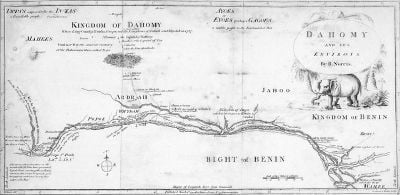
Prior to 1600, present-day Benin comprised a variety of areas with different political systems and ethnicities. These included city-states along the coast (primarily of the Aja ethnic group, and also including Yoruba and Gbe peoples) and tribal regions inland (composed of Bariba, Mahi, Gedevi, and Kabye peoples). The Oyo Empire, located primarily to the east of Benin, was a military force in the region, conducting raids and exacting tribute from the coastal kingdoms and tribal regions.[4] The situation changed in the 17th and 18th centuries as the Kingdom of Dahomey, consisting mostly of Fon people, was founded on the Abomey plateau and began taking over areas along the coast.[5] By 1727, King Agaja of the Kingdom of Dahomey had conquered the coastal cities of Allada and Whydah. Dahomey had become a tributary of the Oyo Empire, and rivaled but did not directly attack the Oyo-allied city-state of Porto-Novo.[6] The rise of Dahomey, its rivalry with Porto-Novo, and tribal politics in the northern region persisted into the colonial and post-colonial periods.[7]
In the Dahomey, some younger people were apprenticed to older soldiers and taught the kingdom's military customs until they were old enough to join the army.[8] Dahomey instituted an elite female soldier corps variously called Ahosi (the king's wives), Mino ("our mothers" in Fongbe), or the "Dahomean Amazons". This emphasis on military preparation and achievement earned Dahomey the nickname of "Black Sparta", from European observers and 19th-century explorers such as Sir Richard Burton.[9]

The kings of Dahomey sold their war captives into transatlantic slavery[10] or killed them ritually in a ceremony known as the Annual Customs. By about 1750, the King of Dahomey was earning an estimated £250,000 per year by selling African captives to European slave-traders.[11] The area was named the "Slave Coast" because of a flourishing slave trade. Court protocols which demanded that a portion of war captives from the kingdom's battles be decapitated, decreased the number of enslaved people exported from the area. The number went from 102,000 people per decade in the 1780s to 24,000 per decade by the 1860s.[12] The decline was partly due to the Slave Trade Act 1807 banning the trans-Atlantic slave trade by Britain in 1808, followed by other countries.[11] This decline continued until 1885 when the last slave ship departed the modern Benin Republic for Brazil, which had yet to abolish slavery. The capital Porto-Novo ("New Port" in Portuguese) was originally developed as a port for the slave trade.
Among the goods the Portuguese sought were carved items of ivory made by Benin's artisans in the form of carved saltcellars, spoons, and hunting horns - pieces of African art produced for sale abroad as exotic objects.[13]
Colonial
By the middle of the nineteenth century, Dahomey had "begun to weaken and lose its status as the regional power." The French took over the area in 1892. In 1899, the French included the land called French Dahomey within the larger French West Africa colonial region.
France sought to benefit from Dahomey and the region "appeared to lack the necessary agricultural or mineral resources for large-scale capitalist development". As a result, France treated Dahomey as a sort of preserve in case future discoveries revealed resources worth developing.[14]
The French government outlawed the capture and sale of slaves. Previous slaveowners sought to redefine their control over slaves as control over land, tenants, and lineage members. This provoked a struggle among Dahomeans, "concentrated in the period from 1895 to 1920, for the redistribution of control over land and labor. Villages sought to redefine boundaries of lands and fishing preserves. Religious disputes scarcely veiled the factional struggles over control of land and commerce which underlay them. Factions struggled for the leadership of great families".[12]
In 1958, France granted autonomy to the Republic of Dahomey, and full independence on 1 August 1960 which is celebrated each year as Independence Day, a national holiday.[15] The president who led the country to independence was Hubert Maga.[16][17]
Post-colonial
After 1960, there were coups and regime changes, with the figures of Hubert Maga, Sourou Apithy, Justin Ahomadégbé, and Émile Derlin Zinsou dominating; the first 3 each represented a different area and ethnicity of the country. These 3 agreed to form a Presidential Council after violence marred the 1970 elections.
On 7 May 1972, Maga ceded power to Ahomadégbé. On 26 October 1972, Lt. Col. Mathieu Kérékou overthrew the ruling triumvirate, becoming president and stating that the country would not "burden itself by copying foreign ideology, and wants neither Capitalism, Communism, nor Socialism". On 30 November 1974, he announced that the country was officially Marxist, under control of the Military Council of the Revolution (CMR), which nationalized the petroleum industry and banks. On 30 November 1975, he renamed the country the People's Republic of Benin.[18][19] The regime of the People's Republic of Benin underwent changes over the course of its existence: a nationalist period (1972–1974); a socialist phase (1974–1982); and a phase involving an opening to Western countries and economic liberalism (1982–1990).[20]
In 1974, under the influence of young revolutionaries – the "Ligueurs" - the government embarked on a socialist program: nationalization of strategic sectors of the economy, reform of the education system, establishment of agricultural cooperatives and new local government structures, and a campaign to eradicate "feudal forces" including tribalism. The regime banned opposition activities. Mathieu Kérékou was elected president by the National Revolutionary Assembly in 1980, re-elected in 1984. Establishing relations with China, North Korea, and Libya, he put "nearly all" businesses and economic activities under state control, causing foreign investment in Benin to dry up.[21] Kérékou attempted to reorganize education, pushing his own aphorisms such as "Poverty is not a fatality".[21] The regime financed itself by contracting to take nuclear waste, first from the Soviet Union and later from France.[21]
In the 1980s, Benin experienced higher economic growth rates (15.6% in 1982, 4.6% in 1983 and 8.2% in 1984), until the closure of the Nigerian border with Benin led to a drop in customs and tax revenues. The government was no longer able to pay civil servants' salaries.[20] In 1989, riots broke out when the regime did not have enough money to pay its army. The banking system collapsed. Eventually, Kérékou renounced Marxism, and a convention forced Kérékou to release political prisoners and arrange elections.[21] Marxism–Leninism was abolished as the country's form of government.[22]
The country's name was officially changed to the Republic of Benin on 1 March 1990, after the newly formed government's constitution was completed.[23]
Kérékou lost to Nicéphore Soglo in a 1991 election and became the first President on the African mainland to lose power through an election.[24] Kérékou returned to power after winning the 1996 vote. In 2001, an election resulted in Kérékou winning another term, after which his opponents claimed election irregularities.[25] In 1999, Kérékou issued a national apology for the substantial role that Africans had played in the Atlantic slave trade.[26]
Kérékou and former president Soglo did not run in the 2006 elections, as both were barred by the constitution's restrictions on age and total terms of candidates.[27] On 5 March 2006, an election resulted in a runoff between Yayi Boni and Adrien Houngbédji. The runoff election was held on 19 March and was won by Boni,[28] who assumed office on 6 April.[29] Boni was reelected in 2011, taking 53.18% of the vote in the first round—enough to avoid a runoff election. He was the first president to win an election without a runoff since the restoration of democracy in 1991.[30]
In the March 2016 presidential elections in which Boni Yayi was barred by the constitution from running for a third term, businessman Patrice Talon won the second round with 65.37% of the vote, defeating investment banker and former Prime Minister Lionel Zinsou. Talon was sworn in on 6 April 2016.[31] Speaking on the same day that the Constitutional Court confirmed the results, Talon said that he would "first and foremost tackle constitutional reform", discussing his plan to limit presidents to a single term of 5 years in order to combat "complacency". He said that he planned to slash the size of the government from 28 to 16 members.[32] In April 2021, President Patrice Talon was re-elected, with more than 86.3% of the votes cast, in Benin's presidential election.[33] The change in election laws resulted in total control of parliament by president Talon's supporters.[34]
In February 2022, Benin saw its largest terrorist attack in history.[35]
On 20 February 2022, President Patrice Talon inaugurated an exhibition with 26 pieces of sacred art returned to Benin by France, 129 years after they were looted by colonial forces.[36]
Economy
The economy of Benin remains underdeveloped and dependent on agriculture, which engages about half the country's population and exists mainly at the subsistence level. Much of the manufacturing is likewise devoted to agricultural implements. Tribal herdsmen tend most of the cattle that go to market. The open-air markets found in every sizable town are where most Beninese shop for everyday articles, including manufactured goods, as well as food.
Cotton, cocoa, and palm oil are the main commercial crops and exports, palm tree plantations having supplanted the natural coastal forests more than a century ago. France remains the major destination of Beninese goods, followed by Brazil. Machinery, foodstuffs, and textiles are Benin's principal imports. A significant amount of smuggling occurs along the porous border with Nigeria. Thousands of Beninese workers have migrated steadily to that country and Gabon for employment in the oil fields.
National Apology
In 1999, President Kérékou convened a conference in Cotonou to apologize for his country's complicated history of involvement with the slave trade of centuries past. European businessmen as well as U.S. Congressmen and governmental representatives from other African countries attended and witnessed Benin's lament of its Slave Coast legacy, particularly the considerable profit that tribal chiefs made by selling their own people into servitude.
The long-term objective is the country's reconciliation with its descendants in the Americas. Recognition was made that Benin has suffered greatly by having lost so many of its ultimate resource, its own people, called "the absent ones." Subsequent apologies have been made by government representatives to foreign, particularly African-American, audiences.
National Character
Beninese are said to be characterized by their wry humor in the face of adversity. Though its history as a republic has seen many forced changes of government, no coup ever ended in the death of an ousted president. Another sign of the relative genialness of Benin is the fact that, unlike the situation next door in Nigeria, adherents of various religions that are otherwise often at odds tend to coexist easily.
Notes
- ↑ Error on call to template:cite web: Parameters url and title must be specifiedCentral Intelligence Agency (2009). . The World Factbook.
- ↑ 2.0 2.1 2.2 2.3 Error on call to template:cite web: Parameters url and title must be specified. International Monetary Fund.
- ↑ Error on call to template:cite web: Parameters url and title must be specified. The World Factbook. CIA.
- ↑ Bay, Edna (1998). Wives of the Leopard: Gender, Politics, and Culture in the Kingdom of Dahomey. University of Virginia Press.
- ↑ Akinjogbin, I.A. (1967). Dahomey and Its Neighbors: 1708–1818. Cambridge University Press. OCLC 469476592.
- ↑ Law, Robin (1986). Dahomey and the Slave Trade: Reflections on the Historiography of the Rise of Dahomey. The Journal of African History 27 (2): 237–267.
- ↑ (2005). Party Politics and Different Paths to Democratic Transitions: A Comparison of Benin and Senegal. Party Politics 11 (4): 471–493.
- ↑ Harms, Robert W. (2002). The Diligent: A Voyage Through the Worlds of the Slave Trade. Basic Books. ISBN 978-0-465-02872-6.
- ↑ Alpern, Stanley B. (1998). Amazons of Black Sparta: The Women Warriors of Dahomey. C. Hurst & Co. Publishers. ISBN 978-1-85065-362-2.
- ↑ Miller, David Lee, "African Ambassador Apologizes for Slavery Role", Fox News, 10 July 2003.
- ↑ 11.0 11.1 African Slave Owners. BBC World Service.
- ↑ 12.0 12.1 Manning, Patrick (1982). Slavery, Colonialism and Economic Growth in Dahomey, 1640–1960. London: Cambridge University Press, 15–16.
- ↑ This ivory relic reveals the colonial power dynamic between Benin and Portugal History Magazine, National Geographic, 09.02.2021.
- ↑ Manning, Patrick (1982). Slavery, Colonialism and Economic Growth in Dahomey, 1640-1960. Cambridge University Press, 15. ISBN 9780511563072.
- ↑ "President Sirleaf congratulates Benin on 57th Independence Anniversary", Agence de Presse Africane, 31 July 2017. (written in en)
- ↑ (2009) Encyclopedia of the Peoples of Africa and the Middle East: L to Z. Infobase Publishing. ISBN 978-0-8160-7158-6.
- ↑ Araujo, Ana Lucia (2010). Public Memory of Slavery: Victims and Perpetrators in the South Atlantic. Cambria Press. ISBN 978-1-60497-714-1.
- ↑ Dickovick, J. Tyler (9 August 2012). Africa 2012. Stryker Post. ISBN 978-1-61048-882-2.
- ↑ (14 December 2012) Historical Dictionary of Benin. Rowman & Littlefield. ISBN 978-0-8108-7171-7.
- ↑ 20.0 20.1 Wikiwix[archive].
- ↑ 21.0 21.1 21.2 21.3 Kneib, Martha (7 January 2007). Benin. Marshall Cavendish Benchmark, 22–25. ISBN 978-0-7614-2328-7.
- ↑ A Short History of the People's Republic of Benin (1974–1990). Socialist.net (27 August 2008).
- ↑ Benin. Flagspot.net.
- ↑ "Official Result in Benin Vote Shows Big Loss for Kerekou", The New York Times, 26 March 1991.
- ↑ "ben007 President Kerekou re-elected in Benin", www.afrol.com.
- ↑ Gates, Henry Louis, "Ending the Slavery Blame-Game {{#invoke:webarchive|webarchive}}". The New York Times, 22 April 2010
- ↑ "President Mathieu Kerekou leaves after 29 years", The New Humanitarian, 7 April 2006. (written in fr)
- ↑ "Boni wins Benin presidential election: official", ABC News, 22 March 2006. (written in en-AU)
- ↑ "Celebration As Boni Takes Over".
- ↑ "Benin's Boni Yayi wins second term - court", Reuters, 21 March 2011. (written in en)
- ↑ "Businessman sworn in as Benin's president", 6 April 2016.
- ↑ "Newly-elected Benin president aims to reduce presidential terms", 26 March 2016.
- ↑ Benin's president wins re-election in preliminary results.
- ↑ Benin vote count begins after opposition groups boycott election.
- ↑ Five rangers, soldier killed in attack in Benin, park management says (in en-US) (9 February 2022).
- ↑ "Le Bénin expose les vingt-six œuvres restituées par la France : « Regardez la puissance de ces objets ! »", 21 February 2022.
Credits
New World Encyclopedia writers and editors rewrote and completed the Wikipedia article in accordance with New World Encyclopedia standards. This article abides by terms of the Creative Commons CC-by-sa 3.0 License (CC-by-sa), which may be used and disseminated with proper attribution. Credit is due under the terms of this license that can reference both the New World Encyclopedia contributors and the selfless volunteer contributors of the Wikimedia Foundation. To cite this article click here for a list of acceptable citing formats.The history of earlier contributions by wikipedians is accessible to researchers here:
The history of this article since it was imported to New World Encyclopedia:
Note: Some restrictions may apply to use of individual images which are separately licensed.


